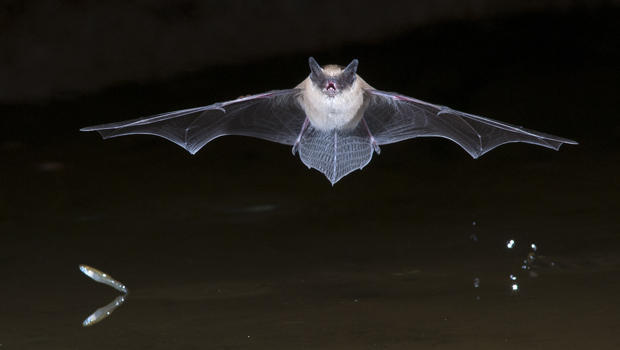Nature up close: Cathedral Caverns
By “Sunday Morning” contributing videographer Judy Lehmberg.
I love caves!
I learned to love them while I was working on bats for my master’s degree. I worked on sperm storage in female bats and discovered that female cave bats, Myotis velifer, have a specialized structure, a spermatheca, where they store sperm from autumn (when the males inseminate the females) to spring, when the females ovulate and get pregnant. That is a pretty nifty adaptation. It allows the females to get pregnant as soon as they come out of hibernation when insects become available.
In most mammals, once the male inseminates the female, sperm have about 48 hours to live, after which they basically burn out because they use a great deal of energy to move and there are no nutrients for them in the female. They live hard and die fast. Some females, including a number of insects, amphibians, reptiles, birds, and mammals, have the ability to store sperm for an extended period of time. The advantage to prolonged sperm storage is that the female can determine when she gets pregnant by when she ovulates. Many insect-eating bats mate in the autumn, but that would not be a good time to get pregnant because they are preparing to hibernate, and pregnancy requires a lot of nutrients -- nutrients a hibernating bat cannot afford to lose.
It took a while for me to find the bats I studied. I had to find them in winter, while they were hibernating, and obviously weren’t moving around. After trying a couple of the more well-known caves in Texas without any luck, I found one on private property not open to the public. I took the advice of spelunkers and unrolled string on my way into the cave. It wasn’t a big cave and it was supposed to be hard to get lost, but I wasn’t taking any chances. I was feeling very confident as I went deeper and deeper into the cave. After about an hour, I came to a constriction. The only way to get through was to crawl on my belly using my fingers and toes to push forward. That didn’t last too long, and I then found myself in an open area where I could stand upright. I continued for another 100 feet or so and then I saw it. My string! I thought I had been going deeper into the cave when I had actually gone in a circle.
I started getting nervous then. Was I lost? Once I calmed down I realized I could still follow the string out. I then began to search to see if I could get deeper in the cave, and discovered I could. After a short distance I found what I was looking for: hibernating bats! I touched one. It felt almost as cold as the surrounding rock. What an amazing animal!
The most common bats in Cathedral Caverns are eastern pipistrelle (Perimyotis subflavus) and big brown bats (Eptesicus fuscus). Both species are insect eaters that hibernate during the winter, and spend the rest of the year sleeping during the day and foraging for insects at night. They, like many bats, use echolocation to navigate and find insects. Generally speaking, the uglier a bat’s face and the larger their tragus (a flap of skin inside the base of their ear), the better their echolocation. That is also how you can tell what a bat eats. If their face is cute, similar to a fox or dog, they eat nectar or fruit, and their echolocation abilities are limited. If they are not so cute, they have great echolocation and probably eat insects. Most insect-eating bats travel many miles at night hunting for their dinner, and will eat hundreds of insects every night.
Cathedral Caverns, located in Cathedral Caverns State Park in Kennamer Cove, Alabama, is a karst cave. Also known as solution caves, karst caves form where the rocks near the Earth’s surface are primarily limestone. Limestone is rock formed in the shallower oceans when corals, foraminiferans (one-celled organisms related to Amoeba which produce calcium carbonate shells or tests) and shelled mollusks settle to the bottom, and also by the precipitation of calcium carbonate. These ancient limestone deposits were once an ocean floor that has been raised above sea level. Freshwater solution channels cut through the underground layers, forming caverns. The beautiful stalactites and stalagmites in limestone caves such as in Cathedral Caverns form when carbon dioxide in rainwater percolates down through the limestone rock, dissolving some solid calcium carbonate to form calcium bicarbonate (Ca++(HCO3 -)2 ).
When a drop of calcium bicarbonate solution enters and hangs from the roof of a cave, the chemical reaction may reverse and the solution may lose a molecule of carbon dioxide, leaving behind a precipitate of solid calcium carbonate. Drop by drop the degassed solution leaves a little residue resulting in a solid tube which ultimately forms a stalactite. Stalagmites form when the drips hits the cave floor.
It is difficult to know how old the stalactites and stalagmites in Cathedral Caverns are. Their growth is largely determined by the drip rate, but a rough average appears to be a growth of about 4 inches every thousand years. Some radiometric dating techniques show some are at least 190,000 years old.
If you are interested in a trip to Cathedral Caverns visit their website.
Judy Lehmberg is a former college biology teacher who now shoots nature videos.
For more info:
- Judy Lehmberg (Official site)
- Judy Lehmberg’s YouTube Channel
To watch extended “Sunday Morning” Nature videos click here!





